-
History of:
- Resources about:
- More:
- Baby walkers
- Bakehouses
- Bed warmers
- Beer, ale mullers
- Besoms, broom-making
- Box, cabinet, and press beds
- Butter crocks, coolers
- Candle snuffers, tallow
- Clothes horses, airers
- Cooking on a peat fire
- Drying grounds
- Enamel cookware
- Fireplaces
- Irons for frills & ruffles
- Knitting sheaths, belts
- Laundry starch
- Log cabin beds
- Lye and chamber-lye
- Mangles
- Marseilles quilts
- Medieval beds
- Rag rugs
- Rushlights, dips & nips
- Straw mattresses
- Sugar cutters - nips & tongs
- Tablecloths
- Tinderboxes
- Washing bats and beetles
- Washing dollies
- List of all articles
Subscribe to RSS feed or get email updates.
Among the various games and sports of an olden Christmas were card-playing, chess, and draughts; jack-puddings in the hall; fiddlers and musicians, who were regaled with a black-jack of beer, and a Christmas pie; also, singing the wassail, scrambling for nuts, cakes, and apples; dancing round standards decorated with evergreens in the streets; the famous old hobby-horse ; hunting owls and squirrels; the fool plough; hot cockles; and the game of hoodman-blind.
Notes & Queries, 1861
Hark! how the wags abroad do call
Each other forth to rambling:
Anon you'll see them in the hall
For nuts and apples scrambling.
From a Christmas poem by George Wither (1588 - 1667)
Nuts for Yule
Nutcrackers, scrambling for nuts, and Christmas
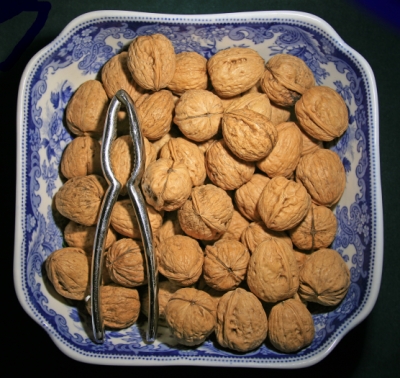 A bowl of nuts, with polished or carved nutcrackers, is part of many traditional
winter holiday feasts. But they don't have to sit beautifully on a table. Scrambling
for nuts on the ground was a tradition for centuries in various European countries.
In Elizabethan England boys would jostle each other to pick up nuts thrown down
during Christmas celebrations. In Germany St. Nicholas scattered nuts on his festival
day (December 6th).
A bowl of nuts, with polished or carved nutcrackers, is part of many traditional
winter holiday feasts. But they don't have to sit beautifully on a table. Scrambling
for nuts on the ground was a tradition for centuries in various European countries.
In Elizabethan England boys would jostle each other to pick up nuts thrown down
during Christmas celebrations. In Germany St. Nicholas scattered nuts on his festival
day (December 6th).
Many of the tables had bundles of rods with gilded bands, which were to be used that evening by the persons who represented St. Nicholas. In the family with whom we reside, one of our German friends dressed himself very grotesquely, with a mask, fur robe, and long tapering cap. He came in with a bunch of rods, a sack, and a broom for a sceptre. After we all had received our share of the beating, he threw the contents of his bag on the table, and while we were scrambling for the nuts and apples, gave us many smart raps over the fingers. In many families the children are made to say, " I thank you, Herr Nicholas," and the rods are hung up in the room until Christmas, to keep them in good behavior.
Bayard Taylor, Views A-foot: Europe seen with Knapsack and Staff, 1847
Nuts fit in well with the feasting of a secular, or pagan, Yule, but they have sometimes been given a religious significance too. The three parts of a nut - a "trinity" of shell, skin, and kernel - symbolised good luck in Italy, while in 16th century Yorkshire one leaflet explained how like "our Saviour's blessed body" they were. Not only did the three-fold nut represent the bones/skin/soul, but it was also described as a reminder of miraculous birth.
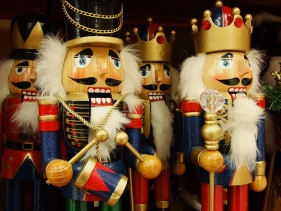 "Character" nutcrackers are
associated with the winter holidays: in North America, in Germany, and elsewhere.
They seem to blend central/eastern European traditions of wooden nutcracker figures
with the Christmas associations of the Nutcracker ballet. Among their less attractive
ancestors may be this grotesque
character waiting to crack a nut in his mouth, or the
devilish figure with nut-cracking legs from a Lithuanian museum. Amusing
wooden figures were developed as souvenir nutcrackers in German-speaking countries
during the 19th century; some cracked nuts in their mouths.
"Character" nutcrackers are
associated with the winter holidays: in North America, in Germany, and elsewhere.
They seem to blend central/eastern European traditions of wooden nutcracker figures
with the Christmas associations of the Nutcracker ballet. Among their less attractive
ancestors may be this grotesque
character waiting to crack a nut in his mouth, or the
devilish figure with nut-cracking legs from a Lithuanian museum. Amusing
wooden figures were developed as souvenir nutcrackers in German-speaking countries
during the 19th century; some cracked nuts in their mouths.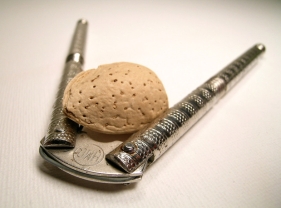
Nutcrackers mostly depend on one of these three methods for cracking nuts: squeezing between "legs" (sometimes called a lever type), screw press designs, and "percussion" or hammering. See these interesting photos of antique nutcrackers of all three types.
For more than 2000 years there have been metal nutcrackers around, but that doesn't mean that people have ever stopped trying to crack them open them with their teeth, or by crushing: with stones or boots, for instance.
For more nutcracker history and pictures, enjoy these two sites:
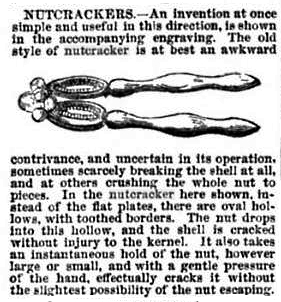
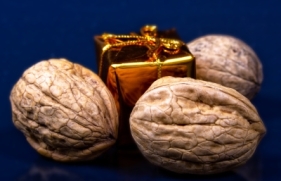 Nutcrackers.org.uk
Nutcrackers.org.uk
The Leavenworth Museum
And on this website see:
Resources for finding out more about culinary antiques
 19 December 2007
19 December 2007
You may like our new sister site Home Things Past where you'll find articles about antiques, vintage kitchen stuff, crafts, and other things to do with home life in the past. There's space for comments and discussion too. Please do take a look and add your thoughts. (Comments don't appear instantly.)
For sources please refer to the books page, and/or the excerpts quoted on the pages of this website, and note that many links lead to museum sites. Feel free to ask if you're looking for a specific reference - feedback is always welcome anyway. Unfortunately, it's not possible to help you with queries about prices or valuation.


